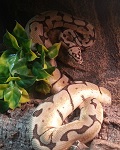» Site Navigation

0 members and 820 guests
No Members online
Most users ever online was 47,180, 07-16-2025 at 05:30 PM.
» Today's Birthdays

» Stats

Members: 75,945
Threads: 249,142
Posts: 2,572,344
Top Poster: JLC (31,651)
|
-
Registered User


Ideally you don't want the glass to get above 95, and substrate thin enough to keep the surface at 90. The thermostat needs to sit in a spot that can regulate it to achieve this consistently. The zoo med pads are kinda thick, and the temp on the top aggainst the glass can vary more than the bottom. The temp fluctuates more between the pad and glass, and the best heat transfer happens in direct contact, so where between the glass and pad can be ok, and set to compensate, IMO in the tank, on the glass, in the middle.of the pad is best, being this is the surface temp you are trying to control. You need a non contact thermometer to check the entire surface to see where the hottest part of the surface is, some arent all that even, and you don't want a small spot hot enough to burn despite most of the pad being a safe lower temp. If the probe gets detatched it can overheat the glass, taping it down is very dangerous to the snake, even a loop of wire can be trouble, so I encase the probe and wire in hot glue directly to the glass. It's non-toxic, not sticky, keeps moisture away from the probe, insulates the probe from getting cooled.by spilled water, easy to clean, and relatively flat. Multi-temp glue melts above 180ish degrees, so only way it will melt is if the stat and heater both short, then you have bigger problems. 95 degrees won't hurt a dresser, but if it's a concern, set it on a peice of cardboard or wood, not something soft like a towel that would block airflow under the tank.
Last edited by alucard0822; 01-10-2015 at 03:57 PM.
-
 Posting Permissions
Posting Permissions
- You may not post new threads
- You may not post replies
- You may not post attachments
- You may not edit your posts
-
Forum Rules
|










 Reply With Quote
Reply With Quote